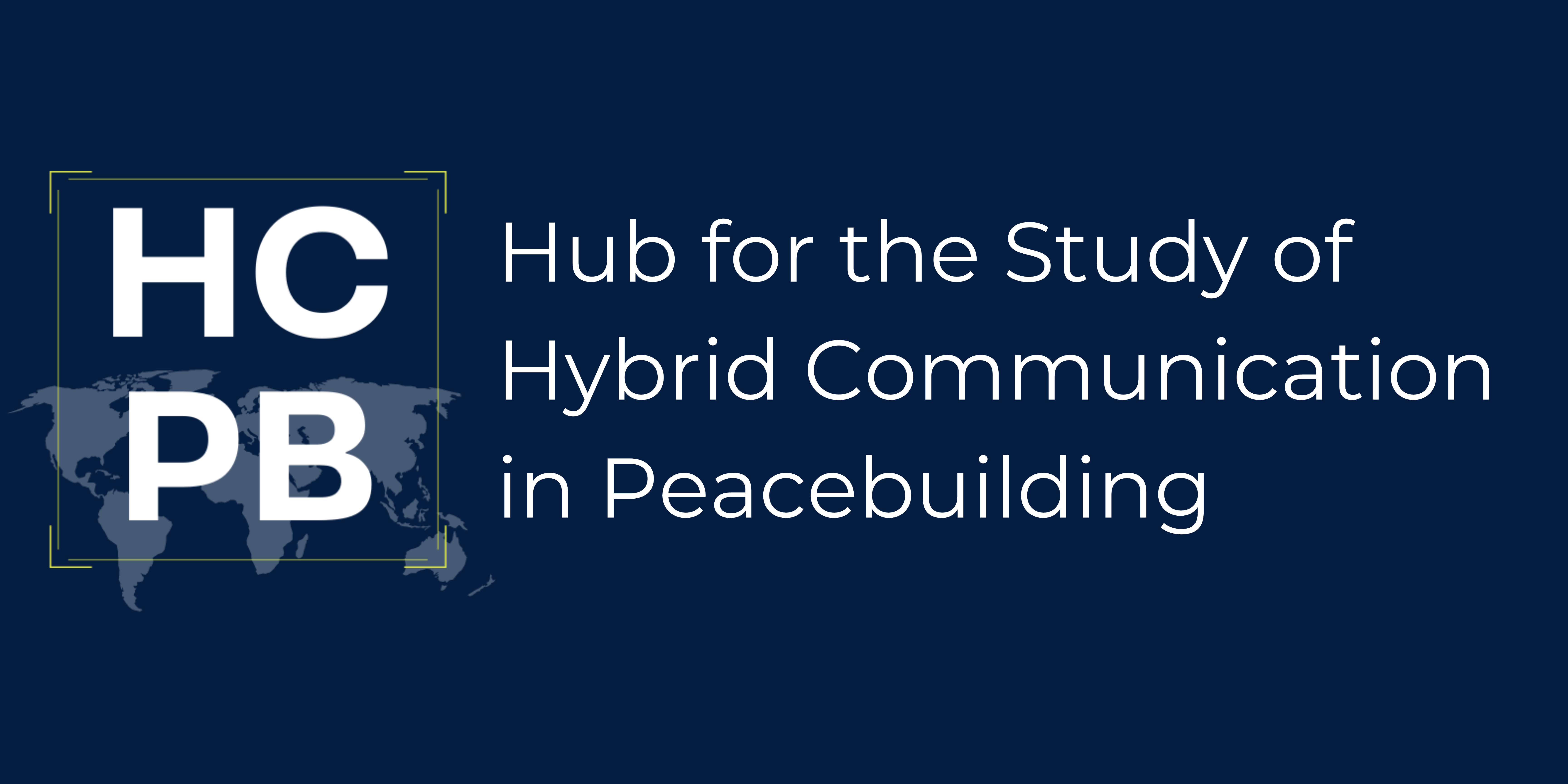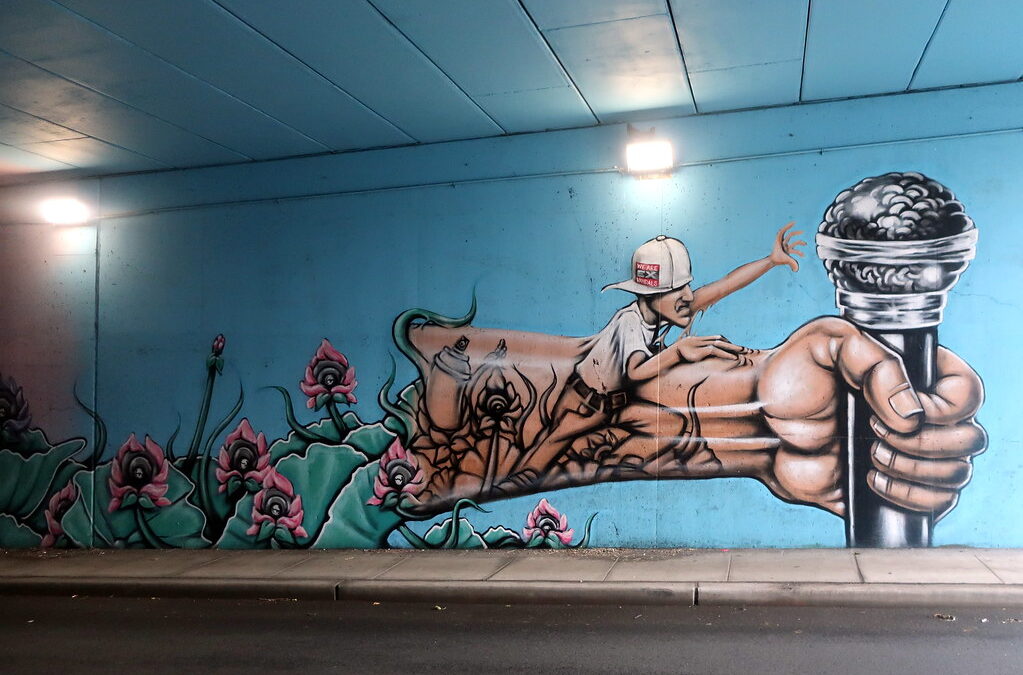By Teresa O Bradaigh Bean and Ruth Daniel, In Place of War
Introduction
Hip-hop culture, consisting of four artistic elements of breakdancing, MC-ing, graffiti and DJ-ing, is a global phenomenon with local scenes across the globe. As a form of popular culture, it does not immediately appear to be a suitable tool or strategy for building peace, often regarded as a youth subculture, a fashion or a fad. However, within the field of peace and conflict studies, there is an increasing body of literature that explores the contribution of popular culture in peacebuilding (Bräuchler, 2018; McEvoy-Levy, 2018; Press-Barnathan, 2017; Lundqvist, 2020). Indeed, as part of this discussion of the ‘cultural turn’ in peacebuilding McEvoy-Levy notes that there is much more continuity between pop culture, political activism, and policy than might be at first assumed.
Drawing on field research from Medellin, Colombia in 2019 undertaken as a part of the AHRC funded ‘Art of Peace’ project led by Prof. Oliver Richmond at the University of Manchester, the blog will argue that it is precisely these unassuming features that make hip hop a suitable tool for peacebuilding amongst youth. In doing so the blog will trace the evolution of hip hop as part of a wider movement for peace and its emergence of ‘Artpeace’ formation. Equally, the blog will explore hip hop as ‘Artivism’ in which peace is created through the carving of safe spaces for socialization into nonviolent values and norms and the presence of positive role models to advocate for and imagine alternative futures. The blog will conclude by reflecting on limitations of the movement against the prevailing backdrop of unfavorable structural conditions, notably the absence of the rule of law and marked inequality.
The conflict in Medellin
Colombia’s second city, Medellin has endured some of the country’s worst episodes of violence over the past six decades. The conflict in Colombia is complex, multifaceted and enmeshed involving the state, rightwing paramilitaries, left wing guerrillas as well as narco and criminal actors. However, the 80s and 90s bore witness to spiraling violence that led to the city gaining the reputation as the most violent city in the world. Whilst the murder rate has decline, violence in the city prevails, evidneced by enduring presence of illicit armed actors controlling territory, high numbers of forced displacement and extorsion.
Hip Hop: The global organizer
It was against such a backdrop that hip hop arrived in Medellin in the late 80s/early 90s. Several local and international conditions can be identified that facilitated the role of hip hop as a form of peacebuilding in the city. Firstly, in the USA, there was a shift in mainstream hip-hop culture, evolving as a more politicized form of cultural expression that advocated for social and political action. This was evidenced in the music of groups such as Public Enemy but also concurrently, at the grassroots hip hop organizations focused on tackling social injustice and poverty.
In Medellin, the heightened levels of violence and youth centric nature of conflict (as both victims and perpetrators) led to increased levels of participation by civil society actors and crucially the mobilization of youth and cultural organizations. The incorporation of both youth and cultural organizations into a wider peace movement provided a suitable external framework in which hip hop culture could evolve and flourish as a form of Artpeace formation. Artpeace formation draws on different local forms of legitimacy, social art practices grow into the wider peace process quite organically. It is transformative and shapes politics but also cultural and social practice in community and local spaces.
Hip hop consists of four elements, Mcing, breakdancing, graffiting and djing (Rose, 1994: 27-33; Jefferies, 2011:1). It is a form of popular culture, an aesthetic and cool practice that is often dismissed as merely a fad, fashion or youth subculture. However, beyond these superficial and mainstream interpretations, the origins of hip-hop culture is rooted in social and political mobilization of marginalised youth. Emerging in New York as a form of protest and resistance to the increasing ghettoization and marginality of black youth in the 1970s, hip hop became a global organizer (Malone and Martinez jr, 2010) mobilizing young people to engage in social and political practice. It has been adopted by marginalized (male) urban youth across the globe as a form of identity building, a means of understanding and responding to social reality and as a form of political protest (Tickner, 2008, Lundqvist, 2021). For marginalized youth hip hop offers an alternative form of communicating messages, pathways to social transformation and reimagined futures.
As a culture, it is guided by a set of principles, a code of conduct for hoppers. The Hip Hop Declaration of Peace, a UN sponsored document advocates for social justice, equality and individual responsibility in constructing a global community built on peace and prosperity (Parmar, P. 2009: 193-198; Malone and Martinez Jr 2010: 542).
Artivism: Embedding a culture of peace and advocating for alternative futures
Amongst hip hop collectives in Medellin, Colombia, the principles outlined in Declaration of Peace are evident in daily actions and behaviour, offering what is coined by hip hop leaders as ‘alternative options for life’ or ‘a dignified life’ for young people at risk of violence and recruitment of gangs. Following the principles of hip hop culture, young people are expected to exhibit positive behaviour in order to be part of a hip hop collective. These include punctuality, achieving good grades at school, maintaining good relationships with peers and family. Hip hop schools are informal spaces, often operating out of school playgrounds, parks or sports grounds that have been set up hip hop collectives to offer young people artistic training and a safe space from violence.
However, rather than merely offering artistic training, hip hop schools are channels for socialization into nonviolence values and norms of respect, acceptance of diversity and peaceful co-existence. They also expose young people to nonviolent role models in the form of hip-hop leaders and peers offering alternative forms of identity and community building. In doing so, they advocate and imagine alternative futures and challenge established power structures and social practice. Given this, hip hop in Medellin can be regarded as facilitating ‘Artivism’ in which peace is formed through the creation of alternative spaces, socialization and identities that subtly and indirectly resist and challenge structures and cultures of violence. 
Transmitting messages and spatial transformation
In the Comuna 13 area of Medellin, an area that has suffered high levels of gang related violence, paramilitary and guerilla activity and military interventions, graffiti has provided marginalised youth with tools for spatial transformation. Graffiti has repurposed public spaces that have been consumed by and associated with violence, depicting individual or collective representations of daily life, past experiences or imagined futures. Thus, it can be understood as a medium for transmitting messages and transforming spaces associated with conflict.
Part of this transformation includes challenging stigma and reintegrating the areas into the wider social fabric of the city. The area’s reputation as the most violent barrio, coupled with its location on the outskirts led to its isolation from the rest of the city. Graffiti has offered a bridge for visitors, facilitating new interactions between local residents, people from other more prosperous areas of the city and international tourists evidenced by the influx of visitors to the area. This has led to the barrio gaining a reputation as an area for urban art.
Economic participation
Graffiti Tours is a 3-hour walking tour of graffiti in Comuna 13 led by local hip hop artists from hip hop school Casa Kolacho. Through graffiti, locals tell their version of the area’s violent history and offer outsiders a glimpse of everyday life in what was once known as the most dangerous barrio in Latin America. Working with language schools and tourism agencies, the area has been one of the most visited, with Graffiti Tours featuring in travel guides such as Lonely Planet. The influx of visitors and international tourists taking the tour has provided income for 40 families and has led to the opening of an array of cafes and restaurants and souvenirs stalls. Thus, offering new forms of economic participation for youth in an area with high unemployment and limited opportunities for social mobility. This has also led to a shift in attitudes towards urban art with the community regarding it as a viable source of income generation for youth. Furthermore, governments from other Latin American countries have visited the area, keen to learn about this model of transformation with a view of implementing such initiatives in other communities affected by violence. Thus, this demonstrates the function of Graffiti as Artpeace formation in shaping and transforming spaces, communities, social practice and influencing policy.
Photo 1 shows MC battle in the sports field in Comuna 13. Photo Credit: Un-Convention Medellin.
Photo 2 shows Young people during a breaking dancing performance in Comuna 8. Photo Credit: Ciudad Comuna.
Also check out a short documentary about arts based peacebuilding in the city as part of the Prof. Richmond’s Art of Peace project. The youtube link is here and the project website is here

